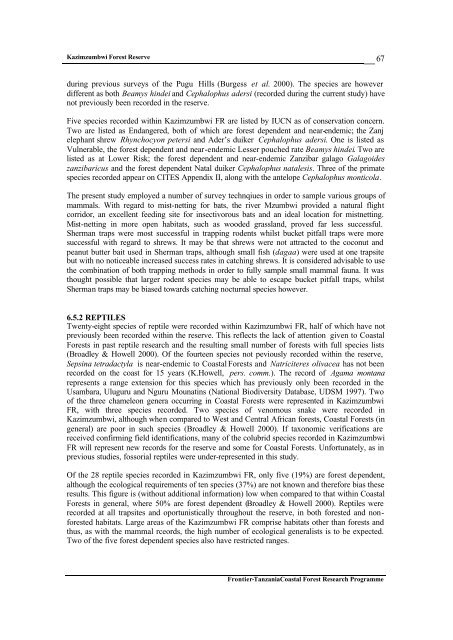Frontier Tanzania Environmental Research REPORT 110 ...
Frontier Tanzania Environmental Research REPORT 110 ...
Frontier Tanzania Environmental Research REPORT 110 ...
Create successful ePaper yourself
Turn your PDF publications into a flip-book with our unique Google optimized e-Paper software.
Kazimzumbwi Forest Reserve<br />
67<br />
during previous surveys of the Pugu Hills (Burgess et al. 2000). The species are however<br />
different as both Beamys hindei and Cephalophus adersi (recorded during the current study) have<br />
not previously been recorded in the reserve.<br />
Five species recorded within Kazimzumbwi FR are listed by IUCN as of conservation concern.<br />
Two are listed as Endangered, both of which are forest dependent and near-endemic; the Zanj<br />
elephant shrew Rhynchocyon petersi and Ader’s duiker Cephalophus adersi. One is listed as<br />
Vulnerable, the forest dependent and near-endemic Lesser pouched rate Beamys hindei. Two are<br />
listed as at Lower Risk; the forest dependent and near-endemic Zanzibar galago Galagoides<br />
zanzibaricus and the forest dependent Natal duiker Cephalophus natalesis. Three of the primate<br />
species recorded appear on CITES Appendix II, along with the antelope Cephalophus monticola.<br />
The present study employed a number of survey technqiues in order to sample various groups of<br />
mammals. With regard to mist-netting for bats, the river Mzumbwi provided a natural flight<br />
corridor, an excellent feeding site for insectivorous bats and an ideal location for mistnetting.<br />
Mist-netting in more open habitats, such as wooded grassland, proved far less successful.<br />
Sherman traps were most successful in trapping rodents whilst bucket pitfall traps were more<br />
successful with regard to shrews. It may be that shrews were not attracted to the coconut and<br />
peanut butter bait used in Sherman traps, although small fish (dagaa) were used at one trapsite<br />
but with no noticeable increased success rates in catching shrews. It is considered advisable to use<br />
the combination of both trapping methods in order to fully sample small mammal fauna. It was<br />
thought possible that larger rodent species may be able to escape bucket pitfall traps, whilst<br />
Sherman traps may be biased towards catching nocturnal species however.<br />
6.5.2 REPTILES<br />
Twenty-eight species of reptile were recorded within Kazimzumbwi FR, half of which have not<br />
previously been recorded within the reserve. This reflects the lack of attention given to Coastal<br />
Forests in past reptile research and the resulting small number of forests with full species lists<br />
(Broadley & Howell 2000). Of the fourteen species not peviously recorded within the reserve,<br />
Sepsina tetradactyla is near-endemic to Coastal Forests and Natriciteres olivacea has not been<br />
recorded on the coast for 15 years (K.Howell, pers. comm.). The record of Agama montana<br />
represents a range extension for this species which has previously only been recorded in the<br />
Usambara, Uluguru and Nguru Mounatins (National Biodiversity Database, UDSM 1997). Two<br />
of the three chameleon genera occurring in Coastal Forests were represented in Kazimzumbwi<br />
FR, with three species recorded. Two species of venomous snake were recorded in<br />
Kazimzumbwi, although when compared to West and Central African forests, Coastal Forests (in<br />
general) are poor in such species (Broadley & Howell 2000). If taxonomic verifications are<br />
received confirming field identifications, many of the colubrid species recorded in Kazimzumbwi<br />
FR will represent new records for the reserve and some for Coastal Forests. Unfortunately, as in<br />
previous studies, fossorial reptiles were under-represented in this study.<br />
Of the 28 reptile species recorded in Kazimzumbwi FR, only five (19%) are forest dependent,<br />
although the ecological requirements of ten species (37%) are not known and therefore bias these<br />
results. This figure is (without additional information) low when compared to that within Coastal<br />
Forests in general, where 50% are forest dependent (Broadley & Howell 2000). Reptiles were<br />
recorded at all trapsites and oportunistically throughout the reserve, in both forested and nonforested<br />
habitats. Large areas of the Kazimzumbwi FR comprise habitats other than forests and<br />
thus, as with the mammal rceords, the high number of ecological generalists is to be expected.<br />
Two of the five forest dependent species also have restricted ranges.<br />
<strong>Frontier</strong>-<strong>Tanzania</strong>Coastal Forest <strong>Research</strong> Programme

















